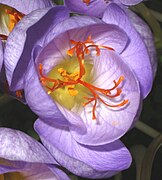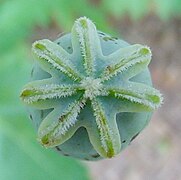Carpel
- See the gymnospermas (female leaf) in: Gymnospermae
In botany, the carpels are modified leaves that form the female reproductive part of the flower of angiosperm plants.
Description
The carpels can appear welded, forming a single pistil, or remain separate or in groups, each pistil seated in the receptacle.
When there is only one pistil, it is said that the flower is gammocarpelar, and if each carpel forms a pistil, it is called dialicarpelar flower.
In the carpels three main nerves can be recognized, two of which run along the edges of the carpel leaf and next to them the ovules are born; these nerves are called the placental nerves. The midnerve of the carpel, homologous to the middle of the nomophiles, is the carpellar nerve.
Because of their nature as leaves carrying megaspores (or macrospores, or female spores, the cells by which the female gametophyte or embryo sac is formed by multiplication), the carpels are megasporophylls (or macrosporophylls).
Gynoecium
The gynoecium is the set of all the carpel leaves or carpels that represent the macrosporophylls, which are joined by their margins enclosing the ovules or seminal primordia that will contain the female gametes inside the cavity they form.
Inside there are one or more cavities, called, "locules" (together the seminal cavity), which contain the ovules waiting to be fertilized, after which they develop into a seed; the ovary and sometimes other accessory structures, after fertilization, develops into a fruit. The region of the inner wall of the ovary where each egg is inserted is called the placenta.
May be composed of one or more pistils. It is the last whorl in a complete flower.
The gynoecium can be made up of one or several carpellal sheets that are free from each other (called dialicarpelar or apocarpic gynoecium) or joined together (called gynoeceal gamocarpelar or syncarpic and being the most frequent), and in it different regions can be recognized:
Pistil
The pistil (lat.:pistillum, -i /pistillus, -i: pylon (pestle)), is each unit made up of an ovary, style, and stigma.
A pistilode is a sterile rudimentary pistil that remains in a male flower and is surrounded by stamens or, in a neutral flower, by staminodia, also sterile.
Structure of the pistil
The parts of which each pistil is made are:
| Part | Description |
|---|---|
| Ovary | Formed by the fertile region of the carpal, the one that encloses the seminal or ovule primaries, which appear attached to a protuberance called placenta. |
| Style | It's the rabille that connects the stigma stigma stigma with the ovary. It is the longest sterile part that serves as a "cannon" where the pollen grains will be deposited, which will be retained by the secretion of estigmatic fluid. Gynese may lack style, in which case the stigma is available directly on the ovary and is called the ovary. sesile stigma. |
| Estigma | It is a papillary surface area, receiver of pollen grains (which each contains a male gamete) once released in it by the pollinating agent. When there is style, it is at its distal end and takes in general the form of a thickening, often divided into branches or areas as numerous as carpals contribute to the pistile. |
All of the carpels that form a pistil in a syncarpic flower contribute equally to each of the listed parts.
The carpels close on themselves, or on each other, to form one or more closed cavities (ovaries) where the seminal primordia are found. "Angiosperms" means "enclosed seed", and they are called that for the above reason. Exceptions to this rule are plants of the winteraceous family.
Ovary
The position of the ovary is decisive in the successive development of the fruit: if the ovary joins the internal wall of the receptacle, it is defined as "infero"; if not, it is said "supero". In the first case, a false fruit will develop, derived from the growth of the ovary and the receptacle; in the second, a fruit itself develops, in whose formation the receptacle does not participate.
One of the terminologies used to describe the ovary refers to the insertion point on the receptacle, where the other floral parts (perianthium and androecium) join and are attached to the surface of the ovary. If the ovary is located above the insertion point, it will be superior; if it is below, infero.
- super ovary: the ovary is on the receptacle and on the insertion point of the other floral parts. It is a conical or convex receptacle, where the ovary will be the high part of the flower. Sepals, petals and stamens will be inserted at the base of the ovary. In this case the flower is defined as hypogine. The fruits derived from a super ovary can be, e.g., Hypericum calycinumdrupas...
- ovarian infero: it is beneath the other verticils on a well concave receptacle, where sepals, petals, and stamens are inserted above the ovary. A flower with inferous ovary is called epigina. Inferous ovaries originate false fruits (e.g. pomo, cinorrodium, Fuchsia) where the receptacle is another floral part participating in the constitution of the fruit.
- ovarian semi-inference or half: it is located in an average position more or less circumcising the receptacle.
The styles and stigmas are positioned above the ovary.
Ova
The ovules will serve to originate the seeds, called for this reason seminal primordia, and appear as globose protuberances on the edges of the carpel leaves.
Within the ovules (representing the macrosporangia) the macrospore (n) will develop, from which the female gametophyte (embryonic sac) will be formed by successive mitosis.
Receptacle
The receptacle will be flat, and the sepals, petals and stamens are inserted at the base of the hypanthum. They are periginous flowers. In some classifications, this typology is not recognized, with many intermediate positions between superior and inferior.
Style
The style is the elongation of the carpels between the ovary and the stigma. Its function is to expose the stigma.
It may be separated from the apical stigma by a collector ring that acts as a brush to drag the pollen as it passes through the staminal tube; for example in the Cardueae tribe of the Asteraceae family, where the style is enclosed in the tube formed by the welded anthers of the 5 stamens. In this way, pollen is concentrated at the base of the stigmatic branches to facilitate self-fertilization in the same flower.
The style in angiosperms can be solid or hollow. In plants with a hollow style, the transmission tissue (where the pollen tubes grow to carry out fertilization) is made up of a layer of highly differentiated epidermal cells that surround a hollow channel (the so-called stylar channel). Pollen tubes grow from the stigma toward the ovary along the surface of that canal, usually through a thin layer of mucilage. In plants with solid styles, on the other hand, the epidermal cells are closely fused and do not leave any space between them. Pollen tubes, in this case, grow between the cells of the transmission tissue (as in the case of Petunia, ) or through cell walls (as in Gossypium, ). Transmission tissue in solid styles includes a pectin-containing intercellular substance, comparable to mucilage, found in the stylar canal of hollow styles. From the point of view of the distribution of both types of styles among the different families of angiosperms, solid styles are considered typical of eudicots and are rare in monocots.
In Apiaceae, the base of the style is thickened, nectariferous and called stylopodium.
Stigma
The stigma is called the sector, more or less extensive, of the surface of the carpels with the capacity to germinate the pollen that is deposited on it. Its surface is generally papillose, where each papilla is a cell, and moist, two features that facilitate the adherence of pollen. Once on the stigma, the pollen germinates, opening up and letting a pollen tube grow from it through which the nucleus or nuclei that carry out the fertilization of the female gametes move.
Contenido relacionado
Dilleniidae
Casuarinaceae
Avellinia





